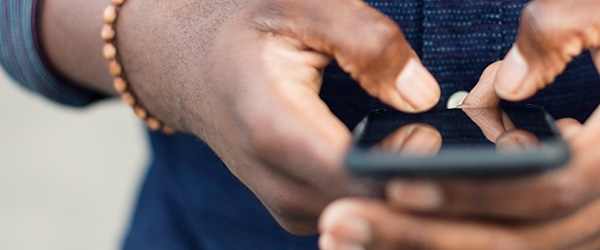Mobile World Congress 2018 has come and gone, and while one of the biggest smartphones of the year launched at the trade show in Barcelona, there’s still a lot of information to glean on what we can expect with smartphones for the rest of the year.
From the continuing bezel-less trend and the return of the notch, to artificial intelligence and ever-improving budget phones, here are the top trends we noticed at MWC.
Bezel-less trend is here to stay
The bezel-less trend, where manufacturers trim the edges around a smartphone screen, is far from over. It all began with the Xiaomi Mi Mix in 2016, and now even Apple has embraced it, increasing the screen size of the iPhone X while cutting the bezels around the screen. The benefit is using a smaller, narrower phone, while getting more screen real estate. For example, Apple’s iPhone X is smaller than the iPhone 8 Plus, but it has a bigger screen.
Narrower devices also mean phone-makers are adopting the 18:9 aspect ratio over the traditional 16:9 ratio, which means you’ll see more content in vertical-scrolling apps, as well as have more space for multi-tasking with split-screen mode. Even budget phones like Alcatel’s new 5 series are adopting the aspect ratio, and that means we can expect the bezel-less trend and the 18:9 aspect ratio to trickle down to more budget phones this year. Hardly surprising, since flagship features are always quick to jump down to affordable devices.
Copying the notch
But there’s one more display-related trend that won’t be going away soon: The notch. If you take a look at the iPhone X, you’ll see a notch-like cutout sticking into the screen at the top. This houses the TrueDepth cameras and sensors that help make Face ID and Animojis work. The notch hasn’t exactly been well-received, but at least it’s packed with plenty of tech powering a bunch of new features. At MWC, it’s evident smartphone manufacturers want to copy the notch design, without adding any nifty features. Instead of using a black stripe like Samsung, device-makers are adding notches to their phones for the sake of copying Apple. We’ve rounded up a few, including Asus with the ZenFone 5, but rumors point to Huawei imitating Apple with the upcoming P20 as well. These notches don’t add much value other than housing the front-facing camera.
Thankfully, some manufacturers are toying around with different designs. Vivo, for example, has a camera protruding from the top of the phone, and Xiaomi put the front-facing camera on a single, bottom bezel. Either way, expect more phones with notches this year until someone figures out how to make a truly bezel-less smartphone.
Everyone’s working on artificial intelligence
LG hardly had a presence at Mobile World Congress, and its only major announcement was a new version of the well-received LG V30. The LG V30S ThinQ has more RAM and more internal storage, but it’s also packed with artificial intelligence. LG’s A.I. improvements come to the camera app specifically, where it can identify scenes and apply the right colors to make a photograph pop. These additions are hardly a reason to buy the phone, but it demonstrates that LG is serious about developing and improving its own A.I. Samsung is also going strong with Bixby, introducing a handful of new camera-related A.I. features to Bixby Vision. A.I. was on the tip of everyone’s tongue, but we’ve yet to see any game-changing improvements like what Google and Apple have already integrated into their respective operating systems. This year, expect to see every phone launching with some type of highlight A.I. feature meant to improve your smartphone experience. Whether it will actually improve anything remains to be seen.
AR still needs a killer app
Like A.I., augmented reality also was a must-have feature at MWC. ZTE’s Blade V9 smartphone has some basic augmented-reality stickers baked into the camera app, but it’s Samsung’s Galaxy S9 that took the spotlight with AR Emojis. Similar to Apple’s Animoji, you can create your own emoji, and use motion tracking to record a video. It doesn’t work as well as Animoji, but it goes a step further by creating a sticker pack based on your likeness. Some of Samsung’s other AR improvements include a makeup tool built into the camera app, allowing people to layer styles on their face and make purchases directly in the app. While both AR Emojis and Makeup are neat additions, we’ve yet to find a game-changing AR app or feature we want to continuously use. We imagine every camera app on every smartphone in 2018 will have a separate category dedicated for augmented reality.
Goodbye wearables
Last year, Huawei launched the Huawei Watch 2 at MWC. In 2018, not a single major manufacturer announced a smartwatch. Yes, there were companies present showing off wearables, but other than the assortment of fitness trackers, hybrid watches, or quirky wearables, we hardly saw any innovation in this category. Wearables aren’t dead, as evidenced by Fitbit and Apple, but competitors still aren’t offering compelling reasons to buy them. Google specifically mentioned improvements to Android Wear will come at its developer conference this year, but we’re not expecting any major developments this year in this category.
Budget and feature phones get better
We say this every year, but budget phones are getting even better. Like bezel-less displays, tech found in high-end smartphones quickly trickle downs to their affordable counterparts. HMD Global’s $345 Nokia 6 is a good example — it’s packed with a lot of tech, and the build quality is excellent. But at MWC this year, Google launched a slew of Android Go smartphones. Android Go is a version of Android for phones with very little RAM and storage, as the core operating system takes up very little space. These phones cost under $100, like the Nokia 1, and they are capable of offering a solid smartphone experience for very little money. We think they’ll prove quite popular, and there are plenty of other budget smartphones to come that are sure to make us question the price tag.
Dumb phones are also seeing some improvement. A company called KaiOS is quickly becoming the operating system of choice for feature phones, such as the Nokia 8110 4G. Before you scoff — there are 1.3 billion feature phone users in the world, and it’s estimated about 600 million of these devices will be sold every year for the next 5 years. Dumb phones are significantly cheaper than touchscreen smartphones, and they often require very little data. KaiOS is bringing smart functionality and apps to these phones, like Google Maps, Google Assistant, and even Facebook, in an effort to bridge the digital divide.
5G looms
You couldn’t walk anywhere at MWC without seeing some type of advertisement or promotion for 5G technology. The fifth generation network aims to bring super-fast internet connectivity speeds, which provides benefits for a variety of services and industries. We spoke to every major U.S. carrier for an update on 5G, and the consensus is we’ll see the technology deployed in various cities by the end of this year. That still doesn’t mean you’ll get to use it until 2019, which is when we expect to see the first smartphone capable of utilizing the network. Everyone’s racing to be the first 5G carrier, or the first smartphone that supports 5G. Expect a lot of talk about download and upload speeds at major smartphone press conferences this year.
Editors' Recommendations
- The top 7 bestselling phones of 2023 were all … you guessed it
- The Pixel 7’s best camera trick is coming to the iPhone and all Android phones
- We just learned an important spec about Apple’s upcoming VR headset
- Amazon’s new AR app lets you have fun with all those Prime Day boxes
- Mobile World Congress 2021 postponed to late June due to COVID-19










